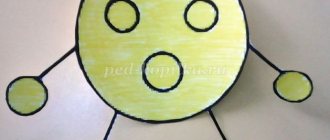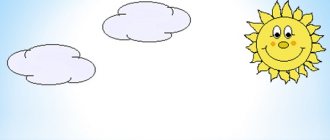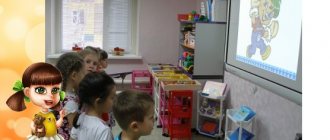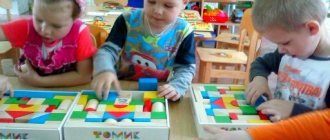Summary of GCD for FEMP in junior group 1 “Visiting the pencils”
Formation of elementary mathematical concepts in the 1st junior group “Visiting the Pencils”
Methodological association for teachers of early age groups “Formation of ideas about the size (length) and color of objects through didactic games in young children”
Synopsis of direct educational activities “Formation of elementary mathematical concepts "in the 1st junior group “On a visit to the pencils”
Compiled by: Chaika T.A., teacher of the 1st junior group of the MDOU kindergarten No. 71, Komsomolsk-on-Amur Purpose: to form in children ideas about the length of objects (long - short) with with the help of a teacher. Objectives: - to develop the ability to compare objects by length (long - short), using the technique of attaching objects to each other, in the process of didactic games “Two paths”, “Catch a fish”, “Choose a pencil”; - consolidate the ability to group objects based on the same color (red, yellow, blue, green) and size (large - small) at the suggestion of the teacher, using the technique of visual correlation of objects during the didactic exercises “Arrange the fruits by color”, “Who lives where?” ", "Catch a fish"; - activate the vocabulary: long, short, red, yellow, blue, green, multi-colored, many, the same, not the same; - create a desire to help the game characters. The planned result of the direct educational activity : children will learn to compare objects by length, using the technique of attaching objects to each other, and to indicate in speech the qualities of objects with the appropriate words (long - short). Equipment and materials: box for colored pencils;
4 knitted large pencils in red, yellow, blue, green; two tracks of red and yellow colors of contrasting length (long and short); 4 houses (soft modules) with Velcro roofs in red, yellow, blue, green colors; 4 felt trees (panels) and fruit figurines for each child and teacher in red, yellow, blue, green colors (apples, pears, plums of the corresponding colors) with Velcro; fruit plate; didactic manual “Fishing” - the sea (imitation of a reservoir), colorful fish (according to the number of children and the teacher) and fishing rods with magnets (one long and one short) 5 pieces; large and small buckets for fish; a box of pencils (long and short) according to the number of children and the teacher. Move
Org moment Game greeting: “Our smart heads” Educator: - Today, our smart heads Will think a lot, cleverly! The ears will listen, the mouth will speak clearly! The backs are straightened, the children are smiling! - Smile at each other, guys. Everyone is in a good mood. Well done! - I have prepared a surprise for you. Look what's in my box? (pencils). Yes, pencils, bright, large. They are different in color. Multi-colored. Say: “colorful.” What color are they? (the teacher asks the children if they wish - red, yellow, blue, green). - Today we will go to visit the colored pencils, they have come up with many interesting tasks for us. Let's hit the road! Main part Didactic game “Two paths”. Educator: - Look, guys, there are paths in front of us. They are different. What color is this track? (red). And what color is this one? (yellow). And these paths are also different, because one is long and the other is short. Our pencils live in their houses far away, so we need to go to visit them along a long path. Now we will find out which path is long and which is short. - Let's try to walk along the yellow path. Follow me. Oh, it's over! We quickly walked along this path, but did not come to the houses. And the red carpet is still going on. - Now let's try to walk along the red carpet. The yellow one is over, but we are still on the red one, it continues. We'll be walking with you for a long time - along the red carpet. We walked and walked and finally came to the houses! - Which path do you think is the longest? Which one is short? (children's answers) So, yellow is a short path. Say: “short” (asks several children). And the red one is long. We came along a long path. Say: “long” (asks several children). Well done boys! Didactic game “Who lives where?” - These are the houses where pencils live. Let's figure out who lives where? — Our houses are also different in color. Multi-colored. Say: “multi-colored” (asks several children). - Let's choose a house for each pencil that is the same color as the pencil! - Which pencil lives in the red house? Why? (the pencil is red and the house is the same red) Sasha, find it and put it next to the house. Say: “The same one, red.” (Similar work with the yellow, blue and green house. The teacher asks different children.) (If the child has difficulty or makes a mistake, the teacher, with guiding questions, helps him correct himself or invites other children to help him. Activate the dictionary: the same, not the same, red, yellow , blue, green) - Good guys, everyone has been resettled in houses! Didactic game “Arrange the fruits by color” - Look, children, near each house they planted a tree with pencils and drew fruits on them. But suddenly such a strong wind blew that all the fruits fell from the trees and scattered. How many fruits did the pencils draw? (a lot of). What are the names of the fruits they drew? (apples, pears, plums). What color are they? We need to put them on plates near the houses. - What color do you think the apples were on the tree near the red house? Go, Seryozha, put the apple on the red plate. - What color do you think the apples were on the tree near the green house? Go, Sasha, put the apple on the green plate. Well done. (Similarly, blue plum and yellow pear) - All fruits are mixed. Let's help the pencils and put them on plates by color (children complete the task independently). (In the event of a child’s difficulty or mistake, the teacher helps him correct himself with leading questions, pays attention to the color of the house and plate, or invites other children to help him. Activate the dictionary: the same, not the same, red, yellow, blue, green) - Oh! Guys! I forgot, I still have 2 apples left in my hand. I want to put them on plates too. I will put a red apple in this plate (the teacher, using the technique of a deliberate mistake, puts a red apple on a plate with yellow fruits), and I will put a green apple in this plate (places it on a plate with blue fruits). (If the children notice a mistake on their own, the teacher offers to correct it, move the apples to the correct color plates. And, if they don’t notice, then the adult pays attention to it and it turns out: “Guys, it seems I mixed something up. The apples ended up on the wrong side plates." The error is corrected, the dictionary is activated: the same, not the same, red, green, yellow, blue) - Well done, guys, helped the pencils, all the fruits are in place, in their plates! Didactic game “Catch a Fish” - And now, pencils invite us to real fishing. Look how beautiful the sea they painted. The sea is a place where fish swim in the water. Show how fish swim in the sea (imitation with your hands - fish swim). - Hurry up and go fishing! How many fish are there in the pond? (a lot of). - Who knows what they use to catch fish when fishing? (children's answers) With a fishing rod. Look, are all our fishing rods the same? (If the children don’t notice, the teacher helps) Let’s check. To do this, let's put them next to each other and compare. The teacher and the children complete the task and voice the result of the comparison. The fishing rods are different - one is long and the rest are short. - Who do you think will fish with a long fishing rod, me or you? (children's answers) Why? (If the children cannot explain why, the teacher helps). I am big, I will fish with a long fishing rod, and you are small, you need short fishing rods. Katya, give me a long fishing rod. Thank you. Take short ones. Let's play - catch a fish! — Guys, our fish are also different, small and large. Which bucket should we put the big fish in? Why? (the fish are big and the bucket is also big) We put the big fish in a big bucket. Which bucket should we put the little fish in? Why? (the fish are small and the bucket is also small) (they catch it together with the teacher and put it in buckets). - Well done! Let's take the buckets of fish to the houses. The final part - Well done, guys! Pencils praise you. They completed all the tasks: they repaired their houses, put the fruit on plates, and caught the fish. The pencils are very happy. They have prepared a gift for you, guess what? — I take the magic wands in my hands. I can draw whatever I want with them. House, river and mushrooms, Sun, sky and flowers. I like sticks, these are the sticks. Wooden on top and colored on the inside. Didactic game “Choose a pencil” - What is it? Yes, real, new colored pencils so that you can draw beautiful pictures (the teacher takes out a box of pencils and invites the children to choose one for themselves). You noticed that the pencils are different. I have a long pencil. Do you have Vanya, and do you have Katya? (and asks other children). Place your pencil next to mine. I have a long pencil and you have a long one too. Artyom, tell me which one you have? (answer) Yours is short, etc. - Let's play with a pencil. Physical exercise “Fun gymnastics with a pencil” (self-massage of fingers and palms with a pencil) - I roll a pencil in my hands. I'm turning it between my fingers. I will certainly teach every finger to be obedient. — We stretched our fingers, and now let’s quickly draw funny pictures.
We recommend watching:
Notes on educational activities on FEMP in the 2nd junior group of a preschool educational institution. Notes on FEMP in the 2nd junior group. Notes on educational activities on FEMP in the second junior group of a preschool educational institution. Notes on cognitive development of FEMP in the younger group. Topic: “Form. Triangle applique
Similar articles:
Notes for mathematics classes in the 2nd junior group
Math lesson notes. Topic: “Equality of objects.” Second junior group
Summary of a lesson on FEMP in kindergarten in the second junior group. Topic: “Circle, square”
Planning classes on FEMP in the second junior group according to the Federal State Educational Standard for a year
Lesson notes on FEMP in the second junior group. January





